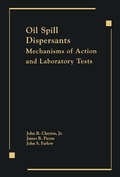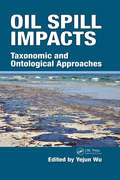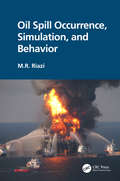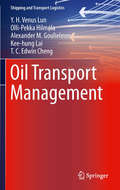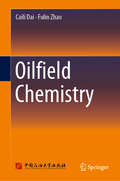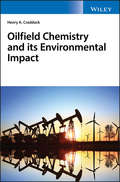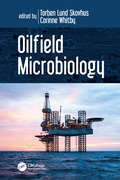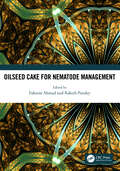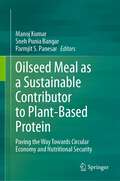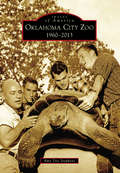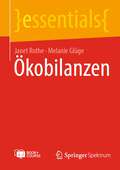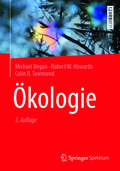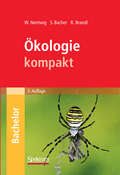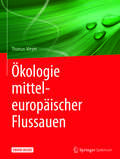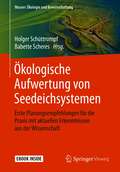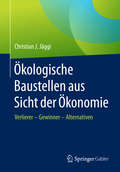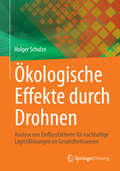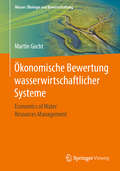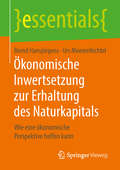- Table View
- List View
Oil Spill Dispersants: Mechanisms of Action and Laboratory Tests
by Clayton/PayneOil Spill Dispersants: Mechanisms of Action and Laboratory Tests provides a comprehensive summary of current information available regarding the general formulation of commercial dispersants and their function to lower oil-water interfacial tension. The book considers how chemical dispersants work for oil spills, the properties and chemistry of oils (including weathering state), the variables that affect dispersant performance, and the relationships between laboratory methods and field situations. The book also considers the strengths and limitations of specific laboratory tests, including brief discussions of the applicability of results for estimating dispersant performance in field trials or conditions encountered during real spill events. Laboratory tests are separated into four groups: tank tests, shake/flask tests, interfacial surface tension tests, and flume tests. Rapid-screen field tests are considered as a separate group. Recommendations for improvements in future laboratory testing are offered as well. Oil Spill Dispersants will be useful for regulators evaluating dispersant agents, field personnel involved with using dispersants, laboratory scientists studying performance and behavior of oil and dispersants, and managers responsible for designing studies related to the treatment of oil slicks with dispersants.
Oil Spill Impacts: Taxonomic and Ontological Approaches
by Yejun WuStarting with the 2010 Gulf of Mexico Deepwater Horizon oil spill incident, Oil Spill Impacts: Taxonomic and Ontological Approaches chronicles a timeline of events that focus on the impact of oil spills and provides an understanding of these incidents using a number of approaches. The book includes an interdisciplinary oil spill taxonomy, an
Oil Spill Occurrence, Simulation, and Behavior (Fuels and Petrochemicals)
by M.R. RiaziOil Spill Occurrence, Simulation, and Behavior provides practical insight into oil spills and their causes, impacts, response and cleanup methods, simple and advanced modeling of oil spill behavior, and oil spill simulation techniques. Discusses various sources of oil spills and major accidents Includes case studies on the 2010 Gulf of Mexico oil spill, including environmental, economic, and political impacts, modeling and behavior as well as response and cleanup methods Introduces some commercial softwares on predicting oil movement and spreading on water Describes properties and characteristics of crude oil and its products needed for simulation and prediction of behavior of an oil slick Written as an applied book with minimal math and theory, making it accessible to a wide range of readers The book includes more than 100 unique and informative images in color This essential book is aimed at professionals, academics, and scientists in the fields of chemical engineering, petroleum engineering, environmental engineering, marine and ocean engineering working on the simulation and modeling, mitigation, and prevention of oil spills.
Oil Spill Remediation
by Ponisseril Somasundaran Kyriakos Papadopoulos Partha Patra Raymond S. FarinatoThis book provides a comprehensive overview of oil spill remediation from the perspectives of policy makers, scientists, and engineers, generally focusing on colloid chemistry phenomena and solutions involved in oil spills and their cleanup.* First book to address oil spill remediation from the perspective of physicochemical and colloidal science* Discusses current and emerging detergents used in clean-ups* Includes chapters from leading scientists, researchers, engineers, and policy makers* Presents new insights into the possible impact of oil spills on ecosystems as well as preventive measures
Oil to Cash: Fighting the Resource Curse Through Cash Transfers
by Caroline Lambert Todd Moss Stephanie MajerowiczWhat should a country do if it suddenly discovers oil and gas? How should it spend the subsequent cash windfall? How can it protect against corruption? How can citizens truly benefit from national wealth? With many of the world's poorest and most fragile states suddenly joining the ranks of oil and gas producers, these are pressing policy questions. Oil to Cash explores one option that may help avoid the so-called resource curse: just give the money directly to citizens. A universal, transparent, and regular cash transfer would not only provide a concrete benefit to regular people, but would also create powerful incentives for citizens to hold their government accountable. Oil to Cash details how and where this idea could work and how policymakers can learn from the experiences with cash transfers in places like Mexico, Mongolia, and Alaska.
Oil Transport Management
by Kee-Hung Lai Alexander M. Goulielmos T.C. Edwin Cheng Olli-Pekka Hilmola Y.H. Venus LunThe first volume in a new Springer Series on Shipping and Transport Logistics, Oil Transport Management provides a full historical account of the evolution of the oil transport industry since the 1800's. In this comprehensive guide, the authors investigate the industry and describe the shipping market and its structure, as well as forecasting, location plan and the transportation chain. They dedicate a separate chapter to each topic to cover various concepts, including: an introduction to the tanker shipping market, including how the freight, new vessel building, second hand and demolition markets influence one another, the economic structure and organization of the tanker industry in both the past and present, and forecasting the need for oil-based sea transportation. Further chapters present case studies and simulations to illustrate the importance of factory location decisions and the need for oil infrastructure investments. Chapter One also includes a regression equation to predict the fleet size in tanker shipping. Oil Transport Management is a key reference, which can be practically applied to wider global research and practices. Ideal for both industry practitioners, and researchers and students of shipping studies, Oil Transport Management provides a concise yet comprehensive coverage of the oil transport industry's history and a guide for its future development.
Oilfield Chemistry
by Caili Dai Fulin ZhaoThis book provides comprehensive information on the youngest member of the petroleum sciences family: Oilfield Chemistry, proposes the chemical agents for addressing current problems, and explains the functions, mechanisms and synergistic effects of various chemical agents
Oilfield Chemistry and its Environmental Impact
by Henry A. CraddockConsolidates the many different chemistries being employed to provide environmentally acceptable products through the upstream oil and gas industry This book discusses the development and application of green chemistry in the oil and gas exploration and production industry over the last 25 years — bringing together the various chemistries that are utilised for creating suitable environmental products. Written by a highly respected consultant to the oil and gas industry — it introduces readers to the principles and development of green chemistry in general, and the regulatory framework specific to the oil and gas sector in the North Sea area and elsewhere in the world. It also explores economic drivers pertaining to the application of green chemistry in the sector. Topics covered in Oilfield Chemistry and its Environmental Impact include polymer chemistry, surfactants and amphiphiles, phosphorus chemistry, inorganic salts, low molecular weight organics, silicon chemistry and green solvents. It also looks at sustainability in an extractive industry, examining the approaches used and the other methodologies that could be applied in the development of better chemistries, along with discussions about where the application of green chemistry is leading in this industry sector. Provides the reader with a ready source of reference when considering what chemistries are appropriate for application to oilfield problems and looking for green chemistry solutions Brings together the pertinent regulations which workers in the field will find useful, alongside the chemistries which meet the regulatory requirements Written by a well-known specialist with a combined knowledge of chemistry, manufacturing procedures and environmental issues Oilfield Chemistry and its Environmental Impact is an excellent book for oil and gas industry professionals as well as scientists, academic researchers, students and policy makers.
Oilfield Microbiology: Proceedings From The International Symposium On Applied Microbiology And Molecular Biology In Oil Systems (ismos-2) 2009
by Torben Lund Skovhus Corinne WhitbyMicroorganisms can be both beneficial and harmful to the oil and gas industry and therefore there is an increasing need for the oil industry to characterize, quantify and monitor microbial communities in real time. Oilfield Microbiology offers a fundamental insight into how molecular microbiological methods have enabled researchers in the field to analyze and quantify in situ microbial communities and their activities in response to changing environmental conditions. Such information is fundamental to the oil industry to employ more directed, cost-effective strategies to prevent the major problems associated with deleterious microbial activities (e.g., souring and biocorrosion), as well as to encourage beneficial microbe activity (e.g. oil bioremediation). The aim of the book is to understand how the technological advances in molecular microbiological methods over the last two decades are now being utilized by the oil industry to address the key issues faced by the sector. This book contains a comprehensive collection of chapters written by invited experts in the field from academia and industry and provides a solid foundation of the importance of microbes to the oil and gas industry. It is aimed at microbial ecologists, molecular biologists, operators, engineers, chemists, and academics involved in the sector.
Oilseed Cake for Nematode Management
by Faheem Ahmad Rakesh PandeyPlant-parasitic nematodes (PPNs) devastate many crop plants, causing billions of dollars in agricultural losses each year. Effective management methods to combat PPNs are synthetic nematicides, but most are non-specific and notoriously toxic and threaten the soil ecosystem, groundwater and human health. The plant by-products, such as oilseed cakes, are sources of bioactive compounds with nematicidal potential. Oilseed cakes are an excellent organic fertilizer, and their bioactive compounds are now gaining importance as they are safe for the environment. This book provides the most comprehensive and up-to-date review of research on the use of oilseed cakes against PPNs. The complete knowledge of better uses of oilseed cakes for nematode management is necessary for developing effective nematode control options to reduce yield loss. Key features: • Describes plant by-products such as oilseed cakes and their potential applications • Explores bioactive compounds from oilseed cakes for agricultural biofertilization and nematicidal activity • Discusses nematode management in vegetable, fruit and legume crops • Covers the use of oilseed cakes and management of the associated challenges This volume is designed and edited to serve as an invaluable resource text for readers associated with plant nematology, plant pathology, plant protection and agricultural science, including researchers, teachers, advanced undergraduates and graduate students and even agricultural extension agents and farmers.
Oilseed Meal as a Sustainable Contributor to Plant-Based Protein: Paving the Way Towards Circular Economy and Nutritional Security
by Manoj Kumar Sneh Punia Bangar Parmjit S. PanesarProtein is one of the most important ingredients of the human diet and is considered crucial for the growth development of all age groups. Studies have set the recommended dietary allowance of protein as 0.8 g/kg body weight per day for healthy adults. The world population is projected to reach 10 billion by 2050 and it will be a significant challenge for the scientific community to overcome the growing demand for protein. The results of global warming, from shifting climactic conditions to unpredictable rainfalls, have further complicated the situation. The search for alternative protein sources that can be both sustainable and renewable is one of the major challenges in the face of potential mass protein malnutrition. Oilseed crops such as soybean, mustard, oil palm, peanuts, cottonseed, flax seed, coconut, canola and sesame are mainly cultivated for the extraction of cooking oil and are underutilized as sources of protein. Oilseed meals contain as much as 50% protein but remain under-valued since they are traditionally utilized as fertilizer or as feed for livestock animals. Numerous recent studies show that oilseed meal sources can be utilized as a sustainable and renewable source of protein and could play a major role in alleviating the global problem of protein malnutrition. Oilseed Meal as Sustainable Contributor to Plant-Based Protein explores oilseed crops that can contribute towards the regular supply of protein in an increasing population and changing climate. Each chapter focuses on a specific oilseed crop including comprehensive coverage of the processing and extraction specifics for each crop plus their amino acid profiles and other functional properties. The application of oilseed proteins for production of bioactive peptides and preparation of value-added products is also covered. This text is useful for food scientists and researchers seeking an updated single source for coverage on all the most important oilseed crops andtheir potential roles in combating protein shortages in a growing world population.
Oilseeds: Health Attributes and Food Applications
by Beenu Tanwar Ankit GoyalOilseeds offer a plethora of opportunities for the food and feed industry, thanks to their high oil and protein content . Their phytonutrients and functional components have attracted the interest of researchers, leading to the development of functional foods. This book gathers the latest scientific information on the nutrients, phytonutrients and health benefits as well as the adverse effects of consuming various conventional and non-conventional oilseeds. In addition, each chapter includes a section comprehensively explaining the use of oilseeds in functional bakery, dairy, and other food products. Given its scope, the book is a valuable resource for students, researchers, nutritionists, food scientists and technologists, and for anyone involved in product development based on oilseed and its components.
Oklahoma City Zoo: 1960-2013
by Amy Dee StephensWhat started as a small menagerie in 1902 officially became Oklahoma City Zoo in 1903. Journey through the second half century of its illustrious history in Oklahoma City Zoo: 1960-2013. Meet the staff and animals and explore the exhibits that propelled it from a third-class animal facility to one of the best zoos in the United States. In the 1960s, its animal population exploded as knowledge of animal care improved. The zoo soon assembled the largest-known collection of hoofed animals. Later, a rare mountain gorilla named M'Kubwa stole newspaper headlines, a third leopard escaped, and the zoo met its first cheetah babies. The opening of Aquaticus in the 1980s "brought the ocean to the prairie" in the form of a dolphin and sea lion show. Elephants, however, remain the queen attraction at the Oklahoma City Zoo. In 2011, the birth of the zoo's first baby elephant baby, Malee, was a crowning achievement in its 110-year history.
Oklahoma Integrated Science (Grade #7)
by Mcdougal LittellMcDougal Littell Science pulls together units from the different categories of science to give you a broad picture of how scientists study nature.
Ökobilanzen (essentials)
by Janet Rothe Melanie GlügeSeit der Industrialisierung im 18. Jahrhundert haben sich Ansprüche an Produkte und ihre Produktionsweise geändert. Kunden sind sich im 21. Jahrhundert der Tragweite ihrer Kaufentscheidung bewusster, sodass Hintergrundwissen zu Produktionsbedingungen und Lieferketten eine immer wichtigere Rolle spielen. Mit Hilfe von Produkt-Ökobilanzen ist eine Ermittlung von umweltschonenderen Produktionsverfahren möglich. Ziel dieses Buches ist es, Ihnen diese Ermittlungsverfahren einfach und praxisnah zu erklären. Wie erstellt man eine Ökobilanz? Anhand von realistischen Beispielen wird gezeigt, wie eine Ökobilanz aufgebaut ist, wie bilanziert und berechnet wird.
Ökologie
by Robert W. Howarth Michael Begon Colin R. TownsendDieses Ökologie-Lehrbuch führt in leicht verständlicher Weise in die Grundlagen - von den theoretischen Fundamenten bis zu Ihren praktischen Anwendungen - ein. Durchgehend farbige Abbildungen, einfache didaktische Elemente und eine Fülle an Beispielen machen dieses Buch zu einem idealen Einstieg in die Ökologie für Studierende aller Studienabschnitte. Neu in der 3. Auflage sind zusätzliche Erläuterungen in Form von Sprechblasen in den Abbildungen und die neue Gliederung des Textes in 5 Abschnitte. Ökosystem und Biogeochemie werden ausführlicher behandelt und hunderte neuer Studien sowohl für die grundlegenden als auch für die angewandten Aspekte der Ökologie werden einbezogen.
Ökologie kompakt
by Martin Lay Roland Brandl Sven Bacher Wolfgang NentwigFür dieses bewährte Ökologielehrbuch wurden viele Dozenten nach ihren Lehrinhalten befragt. Das frische Layout, der strukturierte Text und Prüfungsfragen erleichtern das Lernen und die Vorbereitung auf die Prüfung. Zahlreiche zweifarbige Abbildungen illustrieren die dargestellten Sachverhalte, Tabellen geben Hintergrundzahlen. Für die 3. Auflage wurde das Buch gründlich durchgesehen, viele Sachverhalte wurden aktualisiert und Teilkapitel überarbeitet. Zusätzlich wurden einige neueren Entwicklungen in der Ökologie berücksichtigt.
Ökologie mitteleuropäischer Flussauen
by Thomas MeyerDieses Buch bietet einen fundierten Überblick über die geomorphologische Formung und vegetationsgeschichtliche Entstehung der mitteleuropäischen Auenlandschaften. Der Schwerpunkt liegt auf der Darstellung der Lebensgemeinschaften, zudem wird die außerordentliche Biodiversität dieser stark bedrohten Lebensräume betont. Bodenkundliche, geobotanische und zoologische Aspekte werden im Licht der aktuellen Forschungsliteratur diskutiert. Das Besondere ist der ganzheitliche und interdisziplinäre Blickwinkel, bei dem ökosystemale Zusammenhänge im Fokus stehen.Das Buch vertritt einen wissenschaftlichen Anspruch in der Beschreibung der Lebensformen in Auenbiotopen, möchte aber zugleich dabei nicht auf die Darstellung der Schönheit dieser Landschaften und ihrer faszinierenden Tier- und Pflanzengemeinschaften verzichten. Aussagekräftige und zugleich stimmungsvolle Farbbilder laden den Leser ein, sich mit der Einzigartigkeit der heimischen Auenlandschaften zu beschäftigen.Wissenschaftler und Studierende aus verschiedenen Disziplinen ebenso wie im Naturschutz tätige Praktiker und biologisch interessierte Laien werden die enge Verzahnung von Text und Fotografie in diesem Buch sicherlich zu schätzen wissen.
Ökologisch nachhaltiges Wirtschaften: Grundlagen einer zukunftsfähigen Entwicklung (essentials)
by Thomas GöllingerIn diesem essential werden die wichtigsten Grundlagen des ökologisch nachhaltigen Wirtschaftens erläutert. Nach einer kompakten Klärung der verschiedenen Verständnisse und Bedeutungen von „Nachhaltigkeit“ und „Nachhaltiger Entwicklung“ erfolgt eine Darlegung der prinzipiellen Problematik im Kontext von Ökologie und Ökonomie. Eine Erörterung der diversen Handlungsfelder und Strategieoptionen zeigt die vielfältigen Möglichkeiten bezüglich Effizienz-, Konsistenz- und Suffizienz-Innovationen auf. Schließlich erfolgt ein Blick auf die aktuellen Herausforderungen des Nachhaltigkeitsmanagements.
Ökologische Aufwertung von Seedeichsystemen: Erste Planungsempfehlungen für die Praxis mit aktuellen Erkenntnissen aus der Wissenschaft (Wasser: Ökologie und Bewirtschaftung)
by Holger Schüttrumpf Babette ScheresSeedeiche stellen ein wichtiges Element des deutschen Küstenschutzes dar. Bei der Planung und Konstruktion von Seedeichen werden die hydraulischen Belastungen (d. h. Wasserstände und Wellenparameter) sowie die geotechnischen (z. B. Bodenparameter) und lokalen Randbedingungen (z. B. Platzverhältnisse) einbezogen. Umwelt- und naturschutzfachliche Aspekte werden bislang lediglich durch Nutzung lokaler Ressourcen und Minimalisierung des Ressourcenverbrauchs sowie Ausgleichsmaßnahmen berücksichtigt. Möglichkeiten zur ökologischen Aufwertung des Seedeichsystems stellen (i) natürliche oder naturbasierte Lösungen im Vorland und (ii) eine angepasste Gestaltung des Deichbauwerks selbst dar. Das geplante Werk stellt auf Grundlage aktueller wissenschaftlicher Erkenntnisse erste Empfehlungen für Bemessung, Konstruktion, Monitoring und Unterhaltung ökologisch aufgewerteter Seedeiche zusammen, die eine Steigerung des ökosystemaren Werts unter gleichzeitiger Beachtung der Deichsicherheit ermöglichen.
Ökologische Baustellen aus Sicht der Ökonomie
by Christian J. JäggiDieses Fachbuch beschäftigt sich mit ökologischen Fragestellungen, die in der öffentlichen Diskussion zu wenig Beachtung finden. In vielen Bereichen bleiben die Lösungsansätze und geforderten Maßnahmen eigenartig vage oder werden einseitig ökonomischen Sachzwängen oder Partikularinteressen unterordnet. Der Autor thematisiert exemplarisch unter anderem Probleme der Mobilität, des Lärms und des Elektrosmogs. Dabei wird immer gefragt, wer ökonomisch von diesen Baustellen und der heutigen Situation profitiert und wer die Kosten bezahlt. Konkret zeigt sich das im Gesundheitsbereich, der einerseits einen wachsenden Markt darstellt, anderseits aber auch hohe Kosten verursacht. Schließlich werden mögliche Strategien und Lösungsansätze diskutiert.
Ökologische Effekte durch Drohnen: Analyse von Einflussfaktoren für nachhaltige Logistiklösungen im Gesundheitswesen
by Holger SchulzeSeit 2005 beschäftigt sich der Autor mit Drohnentechnologien. Aber erst seit etwa zehn Jahren kann sich das Drohnen-Business in Deutschland und Europa, bedingt durch die veränderten rechtlichen Rahmenbedingungen und unterstützt durch den politischen Willen, als selbsttragendes Geschäftsfeld entwickeln. Als Gesellschafter-Geschäftsführer eines Drohnenunternehmens hat der Autor in den Jahren 2019 bis 2023 im Rahmen des Antrags auf Zulassung eines Regelflugbetriebs im Bereich der medizinischen Logistik die dafür notwendigen technischen, ökonomischen und ökologischen Konzepte entwickelt. Die im Zulassungsantrag eingereichten Unterlagen dienten der Luftfahrtbehörde als Grundlage für die im Jahr 2023 erteilte Betriebsgenehmigung. Diese Zulassung erfolgte für einen Regelflugbetrieb in der höheren Risikoklasse SAIL III und schloss als erste Betriebsgenehmigung in Europa Drohnenflüge auch über bewohnten Gebieten ein. Die Vorteile des Einsatzes unbemannter Luftfahrzeuge in der medizinischen Logistik liegen auf der Hand: Stichworte wie Geschwindigkeitsvorteil, grüne Logistik und Kostenreduzierung werden oft als Argumente angeführt. Auch wenn hinter das Stichwort „Kostenreduzierung&“ derzeit noch ein großes Fragezeichen zu setzen ist, kann mit dem Einsatz von Drohnen die Logistik im Gesundheitswesen zumindest deutlich flexibler organisiert werden. Eine der Fragen im Antragsverfahren betraf die Umweltverträglichkeit von Drohnenflügen. Umfangreiche Literaturrecherchen und die Auswertung von Forschungsergebnissen ergaben, dass zu diesem Thema noch keine hinreichend praxisrelevanten Ergebnisse vorliegen. Aus diesem Grund fasst die vorliegende Publikation die im Rahmen des Zulassungsverfahrens durchgeführten Recherchen, Untersuchungen und Tests zusammen. Dabei wird eine Systematik angewendet, die Umwelteinflüsse von Drohnenflügen wesentlich komplexer als bisherige Untersuchungen betrachtet. Anstatt allein die CO2-Re-duktion im Vergleich zum Transport von medizinischem Material auf der Straße zu betrachten, kommt ein gesamtheitlicher und vor allem praxisorientierter Ansatz zum Tragen. Um die geringen Auswirkungen von Drohnenflügen auf die Tierwelt nachzuweisen, wurden über 600 Drohnenflüge ausgewertet und Reaktionen von Tieren ermittelt. Wesentliche Inhalte des Buches sind: die Betrachtung von Grundlagen im Bereich des Umweltschutzes und Darstellung einer Auswahl relevanten Datenbestände und Informationsquellen. eine strukturierte Darstellung von unterschiedlichen Bauformen unbemannter Luftfahrzeuge eine Analyse der derzeitigen Entwicklungsrichtungen im Bereich von Drohnen und der für die Antriebe eingesetzten Energieträger eine Darstellung mit dem Transport von Gefahrstoffen verbundenen Herausforderungen in der auf Drohnen basierenden Logistik sowie eine Untersuchung des Einflusses von Drohnenflügen auf die Tierwelt und Vorschläge für die Umsetzung einer umweltschonenden Flugplanung.
Ökonomische Bewertung wasserwirtschaftlicher Systeme: Economics of Water Resources Management (Wasser: Ökologie und Bewirtschaftung)
by Martin GochtDieses Buch vermittelt die notwendigen volkswirtschaftlichen und privatwirtschaftlichen Grundlagen zur Beurteilung wasserwirtschaftlicher Projekte. Es vermittelt die unterschiedlichen Perspektive, ohne deren Berücksichtigung die Ergebnisse leicht falsch verstanden werden. This book provides the necessary fundamentals for assessing water management projects in public economics and in the private-sector. It conveys the different perspectives to the readers, that are needed to prevent missinterpretation of results.
Ökonomische Inwertsetzung zur Erhaltung des Naturkapitals: Wie eine ökonomische Perspektive helfen kann (essentials)
by Bernd Hansjürgens Urs MoesenfechtelIn diesem essential beschreiben Bernd Hansjürgens und Urs Moesenfechtel die Dringlichkeit eines Perspektivenwechsels bei unserem Umgang mit der Natur. Sie schlagen dazu eine ökonomische Inwertsetzung von Ökosystemleistungen vor und zeigen auf, welche Handlungsmöglichkeiten dieser Ansatz dem Naturschutz eröffnet.
Ökosystemdienstleistungen
by Karsten Grunewald Olaf BastianDie Natur liefert uns viele Leistungen gratis: So bildet sich Grundwasser neu, bleiben Böden fruchtbar, erzeugt die Photosynthese pflanzliche Biomasse. Wir Menschen ziehen aus diesen "Ökosystemdienstleistungen" (kurz: ÖSD) vielfältigen Nutzen, sei es für die Ernährung, die Versorgung mit Wasser, für die Erholung oder den Schutz vor Naturgefahren. Große internationale Studien wie das Millennium Ecosystem Assessment haben sich eingehend mit den weltweit von Ökosystemen bereitgestellten Leistungen befasst und eindringlich auf die Folgen hingewiesen, die mit deren Verminderung oder Verlust einhergehen. Dieses hochaktuelle Thema wird von Wissenschaftlern ganz unterschiedlicher Disziplinen bearbeitet. Herangehensweisen, Begriffs- und Methodenverständnis sind entsprechend vielfältig. Was ist zum Beispiel mit Leistungsfähigkeit der Natur oder mit Naturkapital gemeint? Welche Werte der Natur sind besonders wichtig, wie sind sie verteilt und wie beurteilt bzw. vermittelt man sie? Können alle Ökosystemdienstleistungen einzeln und als Summe quantifiziert oder gar monetarisiert werden? Was ist zu tun, damit uns die vielfältigen Leistungen der Natur auch zukünftig zur Verfügung stehen? Das vorliegende Buch erläutert das vielschichtige Konzept der Ökosystemdienstleistungen, zeigt einen methodischen Rahmen zu ihrer Analyse und Bewertung auf und diskutiert Fallbeispiele, vor allem aus Deutschland. Angesprochen sind Wissenschaftler wie Praktiker aus dem behördlichen, ehrenamtlichen und freiberuflichen Bereich, vor allem im Umwelt- und Naturschutz sowie der Regional- und Flächennutzungsplanung, Fachleute aus der Wirtschaft, auf politischen Bühnen Tätige, Studierende sowie alle, die sich für ökologische, ökonomische, ethische und umweltpolitische Grundsatzfragen sowie Belange von Ökosystemen und Landschaften interessieren.
